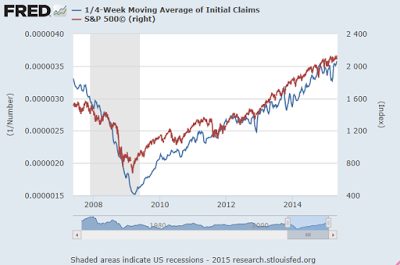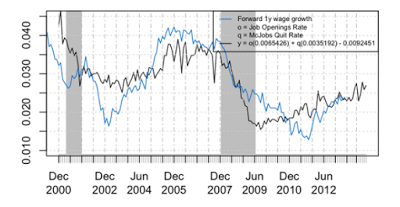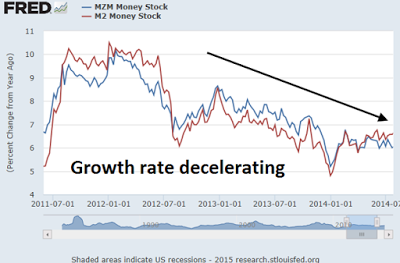I received more than the usual amount of comments in response to my weekend post about unemployment claims (see A scary thought about US employment). With unemployment claims falling to multi-decade lows, I rhetorically asked if this is as good as it gets.

Not mentioned in my post is the close correlation between weekly claims (blue, inverted scale) and stock prices (red).

The real subtext is how the Fed interprets the employment numbers. At what point does the employment picture compel the Fed to act and start tightening?
A steady tightening path
I am seeing more and more Fedspeak and other signals indicating that the stock market should not expect any help from the Fed. On Monday, the WSJ reported that San Francisco Fed President Williams stated that the markets can't count on any further Fed signals about an interest rate hike, as it could happen at any time:
Federal Reserve Bank of San Francisco President John Williams told a television channel Monday that the U.S. central bank is unlikely to provide much warning ahead of an increase in short-term interest rates.
Instead, the official told CNBC that officials will need to go into every policy meetings with an open mind. “We should be coming together every six weeks, discussing what the outlook looks like, and what the right appropriate policy decisions at that meeting are, and adjusting policy” accordingly, Mr. Williams said. The Fed needs “to get out of this business of telegraphing our decisions in advance” and make sure that monetary policy is truly driven by and responsive to incoming economic data.
Mr. Williams said rate rises are “on the table at every meeting” but he would not suggest action is likely to happen at any particular point, although he did say a year from now he believes short-term rates will have moved up off of their current near zero levels.
Telegraphing intentions, especially when the decisions are "data dependent", would create excess volatility:
“You don’t want to make a decision three months in advance and announce that decision when you really have more time to collect data and make the most informed decision you can,” Mr. Williams said.
The official also noted that he accepts that a lack of firm guidance from central bankers could generate more volatility in financial markets.
“We don’t want to be adding noise,” but at the same time, “we don’t want to be absolutely eliminating all uncertainty about our future actions. It’s healthy for the future actions to be uncertain because future conditions can change,” Mr. Williams said.
In a subsequent CNBC interview, Williams argued for an earlier preemptive rate hike to fight inflation, so that further hikes are either not necessary or delayed:
The Federal Reserve hiking interest rates "a bit earlier" allows the U.S. central bank to increase rates more gradually, a top Federal Reserve official said Tuesday.
Inflation shooting above the Fed's 2 percent target would force a more "dramatic" rate hike, San Francisco Federal Reserve President John Williams said Tuesday in prepared remarks before the Harvard Club of New York. Market watchers have eyed indications of when the Fed may abandon its near-zero interest rate policy.
Preparing the markets
In addition, Janet Yellen's remarks last week were generally interpreted as preparing the markets for a rate hike (via Reuters):
I would highlight that equity market valuations at this point generally are quite high. There are potential dangers there...
We’ve also seen the compression of spreads on high-yield debt, which certainly looks like a reach for yield type of behavior...
When the Fed decides it’s time to begin raising rates, these term premiums could move up and we could see a sharp jump in long-term rates. So we’re trying to ... communicate as clearly about our monetary policy so we don’t take markets by surprise.
In other words, better let the markets get a little unsettled now and adjust to the idea of higher rates now, than to have it be surprised and crash later.
New York Fed President William Dudley more or less said the same thing in a speech delivered on Tuesday, which appears to be part of a coordinated Fedspeak campaign to prepare the markets for interest rate normalizaton.
To be as direct as possible: I don’t know when this will occur. The timing of lift-off will depend on how the economic outlook evolves. Since the economic outlook is uncertain, this means the timing of liftoff must also be uncertain.
In other words, the Fed isn`t going to give us any more signals because they don`t know. But then, they`ve told us repeatedly what needs to happen for rates to rise, so what happens next shouldn`t be a big surprise:
At the same time, though, I can be clear about what conditions are needed for normalization to begin. If the improvement in the U.S. labor market continues and the FOMC is “reasonably confident” that inflation will move back to our 2 percent objective over the medium-term, then it would be appropriate to begin to normalize interest rates.
Because the conditions necessary for liftoff are well-specified, market participants should be able to think right along with policymakers, adjusting their views about the prospects for normalization in response to the incoming data. This implies that liftoff should not be a big surprise when it finally occurs, which should help mitigate the degree of market turbulence engendered by lift-off.
We should be able to make an educated guess as to liftoff timing. Indeed, Matt Busigin modeled wage growth based on JOLTS data. The latest release is pointing to rising wages, which is a key metric of inflationary pressure watched by the Yellen Fed.

What normalization looks like
A glance at money supply growth, which has had a relatively high level of correlation with stock prices, shows that both MZM and M2 growth has been decelerating, which is indicative of the normalization process.

Here is my key takeaway from all the Fedspeak. Rates are going to rise this year. When that happens, don't expect a Yellen Put. Don't expect the Plunge Protection Team cavalry to appear at the crest of the hill should the stock market start to fall.
Is it any wonder that the bond markets are acting up?
Disclosure: Cam Hui is a portfolio manager at Qwest Investment Fund Management Ltd. ("Qwest"). This article is prepared by Mr. Hui as an outside business activity. As such, Qwest does not review or approve materials presented herein. The opinions and any recommendations expressed in this blog are those of the author and do not reflect the opinions or recommendations of Qwest.
None of the information or opinions expressed in this blog constitutes a solicitation for the purchase or sale of any security or other instrument. Nothing in this article constitutes investment advice and any recommendations that may be contained herein have not been based upon a consideration of the investment objectives, financial situation or particular needs of any specific recipient. Any purchase or sale activity in any securities or other instrument should be based upon your own analysis and conclusions. Past performance is not indicative of future results. Either Qwest or Mr. Hui may hold or control long or short positions in the securities or instruments mentioned.
